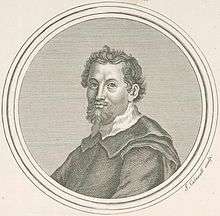Ruggiero Giovannelli
Ruggiero Giovannelli (c. 1560 – 7 January 1625) was an Italian composer of the late Renaissance and early Baroque eras. He was a member of the Roman School, and succeeded Palestrina at St. Peter's.

Portrait by James Caldwall.
Life
He was born in Velletri, near Rome. It has been claimed that he was a student of Palestrina, but there is no documentary evidence of this; stylistic similarities between their music, and an obvious close career association, make it a reasonable assumption. Not much is known about Giovannelli's life until 1583 when he became maestro di cappella at S Luigi dei Francesi, a post which he held until 1591, at which time he went to the Collegio Germanico.[1] In addition to these posts he was maestro di cappella for Duke Giovanni Angelo of Altaemps, at his private chapel, probably concurrently with his other jobs. He also sang, and served in various administrative posts.
Giovannelli's most important appointment was as the replacement for Palestrina as the maestro di cappella at the Julian Chapel at St. Peter's, on 12 March 1594, a position which he held until 1599, when he became a singer at the Sistine Chapel. In 1614 he became maestro di cappella at the Sistine Chapel, and he retired in 1624. He is buried in the church of Santa Marta.
Music and influence
Giovanelli composed and published a large number of secular pieces. He is noted for his church music, most of which also survives in manuscript.[2] As could be expected for a composer of the Roman School, his sacred music was conservative, and mostly in the Palestrina style for the first part of his career; however, after 1600 he experimented with some of the stylistic innovations which defined the beginning of the Baroque era, such as the concertato principle and the basso continuo. His output of sacred music fell off dramatically late in his life, and at least one scholar[3] has suggested that this was because he was uncomfortable with the new style. In 1615 he created a new edition of the Graduale known as the Medicean, published by the Medici press. (The Encyclopedia Americana may contradict this, writing that a Editio Medicæa of the Graduale of 1614 was created by Felice Anerio.)
He wrote masses and motets, some of which are for as many as 12 voices, and which often use polychoral techniques.
For a Roman School composer and a priest he wrote a surprising amount of secular music, mostly madrigals and canzonettas, some of which are in a light-hearted style influenced by northern Italian models, or by Luca Marenzio, who had spent time in Rome. He wrote three books of madrigals for five voices and two books for four voices, as well as a large quantity of other secular songs which were not collected in publications; most have been dated to the 1580s and 1590s.
Giovannelli's music was reprinted widely, in Italy and elsewhere, indicating his broad popularity.
Compiled works
Sources are incomplete, and may differ about his published works. There appear to have been at least three volumes of five books, five- and eight-part motets and three part canzonets (or canzonettes, instrumentals performed as entrances or introductions) (1592); Villanelle a 3 voci (1593); Misse (1593); Motetti (1594); Madrigale (1586); Book Three for Five Voices (1599);[4] Vilanelle a 5 voci (1608). There are masses, motets, and psalms in manuscript at the Vatican Library, among them a Miserere for four and eight voices and a mass for eight, on Palestrina's madrigal Vestiva i colli. Other madrigals are in the collections of Scotto and Phalesisu; and motets and psalms in those of Fabio Constantini and Proske.[5]
Various named works
- Il primo libro de madrigali (1586)[6]
- Il secondo libro de madrigali (1593)
- Terzo libro de madrigali a cinque voci
- 3 motets for equal voices
- Carmina Sacra; 17 motets for 3 equal voices
- La Terra, che dal fondo
- O Fortunata Rosa
- Tu nascesti
Available scores
Midi
- Midi performance of Sancti-Maria[13]
Notes
- Allmusic, Keith Johnson
- Deford, in The New Grove Dictionary of Music and Musicians
- Haydn's Universal Index of Biography from the Creation to the Present Time, Joseph Haydn, James Bertrand Payne, Benjamin Vincent, E. Moxon, 1868 (Google Books)
- Cyclopedia of Music and Musicians, John Denison Champlin and William Foster Apthorp, C. Scribners's sons, 1899 (Google Books)
References and further reading
- Dedford, Ruth I. (1980). "Ruggiero Giovannelli". The New Grove Dictionary of Music and Musicians. London: Macmillan Publishers. ISBN 1-56159-174-2.
- Reese, Gustave (1954). Music in the Renaissance. New York: W.W. Norton & Co. ISBN 0-393-09530-4.
External links
| Wikimedia Commons has media related to Ruggiero Giovannelli. |
![]()